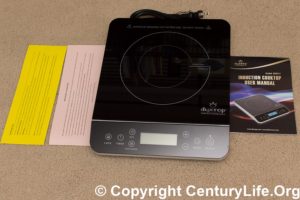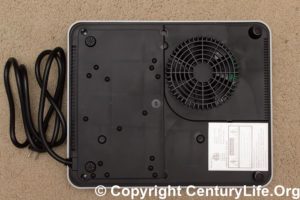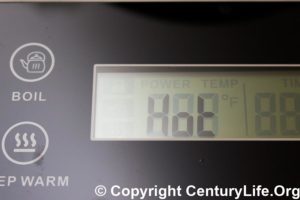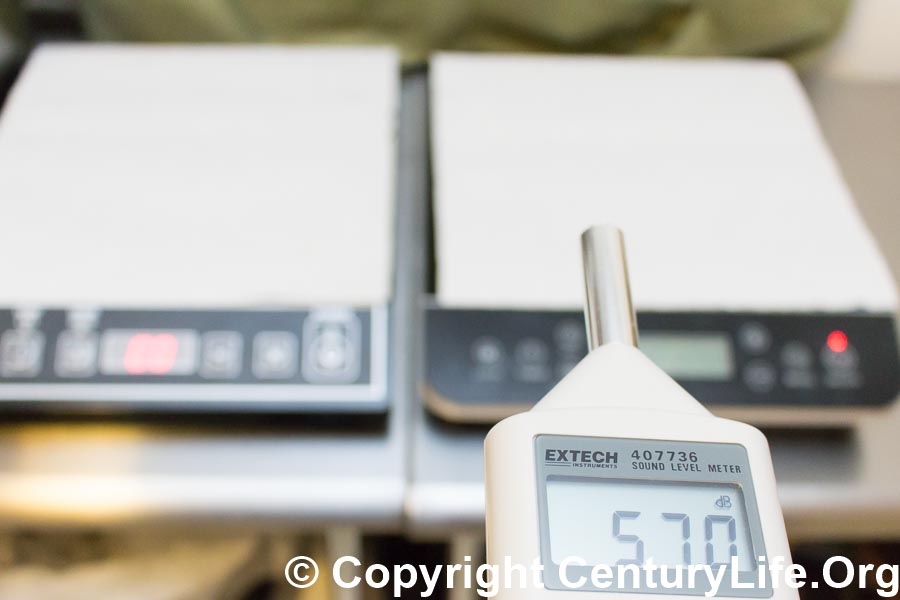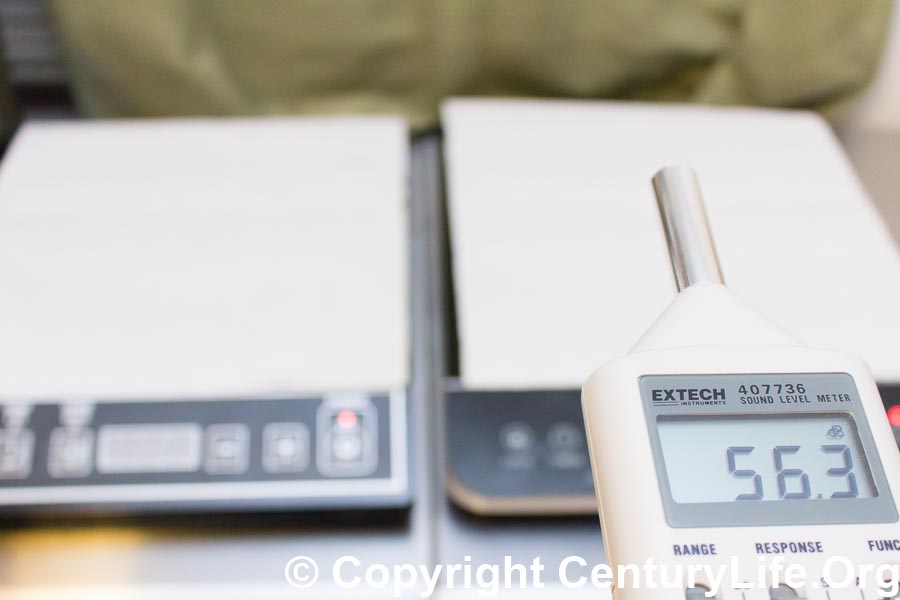PRODUCT REVIEW
This product review is for the Secura LCD Duxtop 9600LS 1800-Watt Portable Induction Cooker (Countertop Burner).
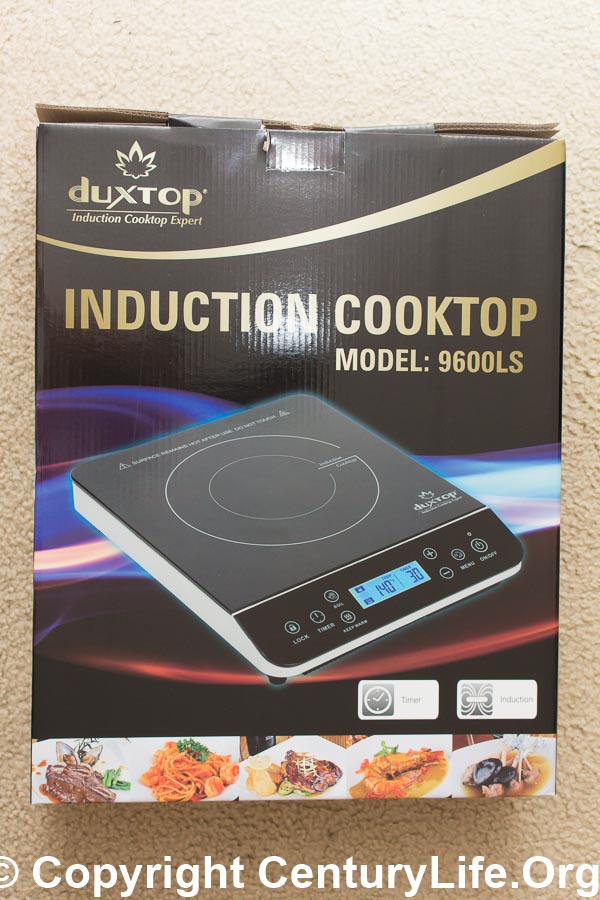
Background:
Secura, Inc. is a household appliance manufacturer based in Blaine, Washington state near the Canadian border. In additional to induction cooktops, Secura sells steamers, ovens, water boilers, and other such household goods.
One of Secura’s popular brands is Duxtop. They make both induction cookers as well as induction-compatible cookware, but you don’t need to use Duxtop cookware to enjoy Duxtop induction cookers. (If you’re looking for good cladded, induction-compatible cookware, see this comprehensive article I wrote.)
The Good:
The Secura LCD Duxtop 9600LS 1800-Watt Portable Induction Cooker (Countertop Burner) is an upgraded version of its popular 9100MC induction cooker. The 9600LS has extremely similar specifications, such as featuring a six-foot long power cord, 1800 watts maximum power, what appears to be a six- or seven-inch diameter induction coil similar to its predecessors (so the diameter of the circle of maximum heat is ~3.5 inches), auto shut-off if it overheats or does not detect a compatible pan, the ability to increment a self-timer in 1-minute increments rather than 5-minute increments like cheaper induction cookers (below $250), and an internal thermometer underneath the ceramic/glass top of the unit.
The 9600LS is almost the same size as the 9100MC (11 x 11 inch flat cooking square; the front panel adds another 3 inches to the front, so the entire unit is 11 inches wide and 14 inches deep including the front control panel. The unit is 2.5 inches high, compared to the ~2.7 inches of the 9100MC).
So what are the differences between the Duxtop 9100MC and the Duxtop 9600LS?
- The 9600LS has a built-in timer that goes up to 10 hours rather than 170 minutes, which allows you to use it as a de facto slow cooker if you want. That’s pretty self-explanatory.
- The 9600LS utilizes touchscreen buttons instead of physical buttons. You have to push and hold the power button for a couple of seconds before it will start–a safety feature to prevent kids/pets from turning the unit on by accident. After the unit is on, you have to push Menu to set the unit to either manual mode or to temperature-target mode. You can also set a timer or preset Boil and Keep Warm modes. This may sound confusing, but in actual use, it’s very easy.
- The 9600LS also has 20 power settings rather than 15 and is somewhat better at avoiding scorching food. Both models have way more power levels than the 10 or fewer power levels you get with most cheap induction cookers. Below you can see the differences in wattage levels between the 9100MC and 9600LS:
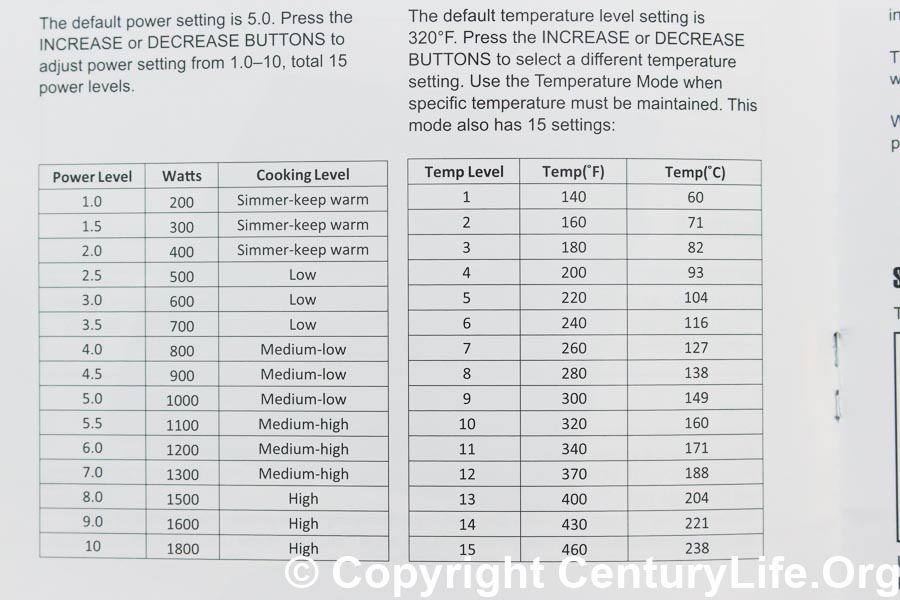
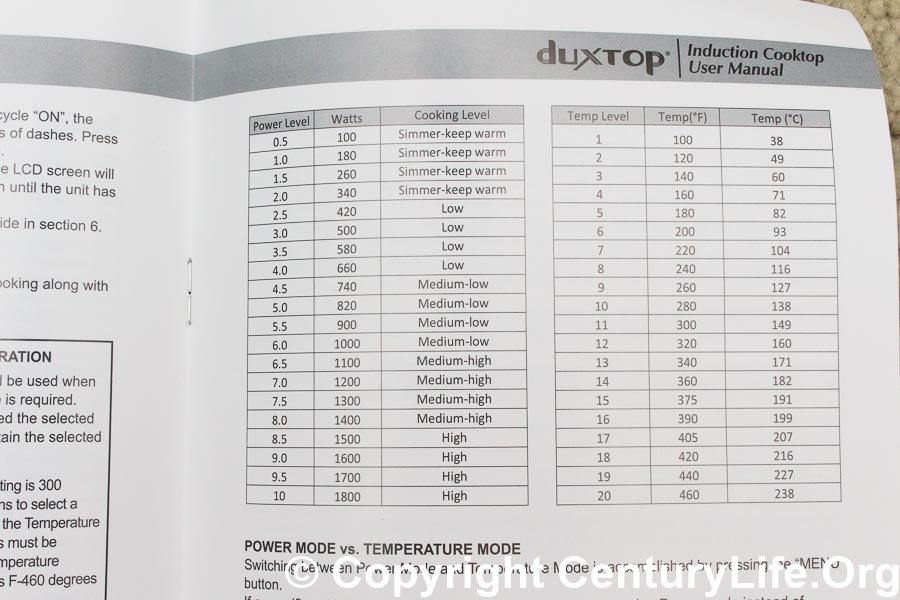
As you can see, the wattage-equivalents are not linear; you get more control at lower wattage and less control at higher wattage–exactly what a chef needs. When you need lower power, like for simmering stock or making delicate sauces, you want as much control as possible. In contrast, once you are over 1,300 watts you are into super-hot zone where fine-grained control doesn’t matter as much; you would likely only use those high settings for boiling water.1
There’s a catch, though: like all cheap induction cookers, both Duxtops cheat on the low end. They pulse on for a moment and then turn off for a moment. That might average out to the claimed wattage in the manual, but that’s sort of like claiming that a zebra is gray. A zebra has alternating black and white stripes and is not gray.
This is the rough pulse-on/pulse-off schedule for the Duxtop 9100MC:
Power Level 1.0 = 6/7 seconds on/off, listed as 200W average which implies the 6-second jolt averages 433W
Power Level 1.5 = 8/6, implies the 8-second jolt averages 525W
Power Level 2.0 = 9/4, implies the 9-second jolt averages 577W
Power Level 2.5 = 11/3, implies the 11-second jolt averages 636W
Power Level 3.0 = 12/2, implies the 12-second jolt averages 700W
Power Level 3.5 = 100% on, implies a continuous 700W
This is the rough pulse-on/pulse-off schedule for the Duxtop 9600LS:
Power Level 0.5 = 3/11 seconds on/off, listed as 100W average which implies the 3-second jolt averages 467W
Power Level 1 = 5/9, which implies the 5-second jolt averages 500W
Power Level 1.5 = 5.5/8.5, which implies the 5.5-second jolt averages 660W
Power Level 2 = 6/8, which implies the 6-second jolt averages 793W
Power Level 2.5 = 7/7, which implies the 7-second jolt averages 840W
Power Level 3 = 8/6, which implies the 8-second jolt averages 875W
Power Level 3.5 = 9/5, which implies the 9-second jolt averages 902W
Power Level 4 = 11/3, which implies the 11-second jolt averages 840W
Power Level 4.5 = 12/2, which implies the 12-second jolt averages 863W
5 = 100% on, implies a continuous 820W
What does this mean?
It means that the Duxtop 9600LS is somewhat better than the 9100MC when it comes to low-temperature cooking such as maintaining a steady simmer. The 9100MC might jolt a pot with 433 watts for six seconds, which could be enough to overheat food, especially if you’re using thin pans. In contrast, the 9600LS is gentler, blasting a similar wattage for only half the time (three seconds) and allowing for plenty of recovery time in-between jolts. That results in less chance of overheating food. Even as you climb up the power levels, the 9600LS should allow for finer control. I’ve tried this on various foods such as potstickers and pancakes, and in real-life testsing, the 9600LS does seem to result in less risk of overheating.
If you just want a unit to boil water, then it’s a tie because both will blast the pot of water with a steady wattage.
Most cheap induction cookers are worse. For instance, my old Tatung induction cooker had 6 power levels, but the lowest settings were very crude. Even at minimum power level on the Tatung, you would get alternating intervals of 1500-watt induction activity and then zero induction activity, each interval lasting several seconds. Those high-wattage pulses can burn food in contact with the bottom of the pot. You can’t “un-burn” food once it’s burned, no matter how many seconds of zero wattage you give it.
The Meh:
The 9600LS will flash “hot” until its temperature sensor cools down, which is a safety feature. You can also Lock the settings to prevent kids or pets from changing them until the unit is unlocked/turned off (useful as a safety feature if you are doing a long cooking session). And the unit won’t even turn on until you press and hold the on button for a few seconds–also to lock out kids and pets.
The 9600LS comes with two presets: Boil and Keep Warm.
The Boil mode just cranks the unit to maximum power and sets a timer for 10 minutes, after which the unit turns off. I often boil for longer than 10 minutes so this preset is of limited use to me.
The Keep Warm mode button sets the unit to temperature-target 140F for 30 minutes. I never use this, instead just setting the unit to 140F and leaving it on indefinitely. But I can see why it could be useful if 30 minutes is an appropriate time for your needs.

The Bad:
It bears mentioning that both units have temperature sensors underneath the ceramic, but no, I would not trust them. That’s because the temperature probe is underneath the ceramic, so there is a lag time between when the pan bottom reaches X temperature and when the ceramic senses it. For longer cooking tasks like simmering for a long time, the temperature of the thermometer and the pan bottom will be closer, though the thermometer will still slightly underestimate the temperature of the pan’s cooking surface by ~15 degrees Fahrenheit. So use a lower temperature target to compensate.
If you really want to know how temperature targeting works, it goes like so:
Let’s say you are making a thick stew. You set the induction cooker to, say, 200F. The unit looks at your room-temperature stew (70F) and decides that the 130F difference means that it needs to hurry up and close the gap. So the unit blasts maximum heat into the pot until its temperature sensor reads 200F, then inputs just enough power to stay at 200F indefinitely. (Higher-end units have a smoother transition between full power and minimal power.)
The problem is this that induction is different from electric coil/radiant smoothtops/gas because the hottest part of the system is not the stovetop, but rather the pot’s bottom. So if you blast max power into the pot bottom, that quickly heats up the pot, but the temperature sensor underneath the ceramic won’t notice for a long time because ceramic takes a long time to heat up. Your oblivious temperature sensor might think the stew is only at 150F when in fact it’s already 500F and scorching.
The workaround is to avoid using temperature-target until the ceramic warms up a bit. In the stew example above, you might use low or medium power for a several minutes while stirring, before setting a temperature target of 200F or whatever. Give that temperature sensor beneath the ceramic time to catch up to the real temperature of the pot. This is where cooktops that do not pulse on-and-off too much excel: you don’t have to rely on flawed temperature targets and have less chance of scorching your food during the “on” parts of the pulsing.
The front panel of the 9600LS is angled, unlike cheap portable induction units that look like flat tablets and as a result can have hot pan edges overheat the electronic control panel. The power/temperature/timer are displayed via a blue LCD panel.
Just like the 9100MC, the 9600LS has a somewhat loud fan–this is typical among cheap (sub-$250) induction cookers–but the 9600LS is mildly quieter (by ~1 decibel at 12 inches distance), but more importantly it sounds smoother to our ears. It’s hard to describe but basically the 9600LS fan sounds less stressed. (For reference, 56.3 decibels is louder than a conversation at home and quieter than conversation in an office–and that’s at 12 inches.2 Chances are your ears will be farther away from the unit.)
Both the 9100MC and 9600LS emit high-pitched squeals at maximum power (so avoid cranking power up to max if you have sensitive hearing). In the words of Ann: “It sounds like two pieces of metal rubbing against each other.” This happens regardless of whether a pan is full or not, or if you put paper towels between the cooker and the pan or not (which is how I’ve reduced that problem before with particularly noisy cookware). I’ve tried all sorts of combinations with four different Duxtops, and they all emit this sound. On the plus side, this squealing isn’t worse than other cheap induction cookers, and maybe I just have extra-sensitive hearing because very few Amazon reviewers mentioned the sound. And Ann didn’t notice the sound until I asked her to put her ear right next to the cooker.
The cooker uses a 2-prong plug; the manufacturer can get away with an ungrounded plug because the cooker is encased in plastic, which doesn’t conduct electricity, so even if the internal wiring somehow falls apart, you should be safe anyway.
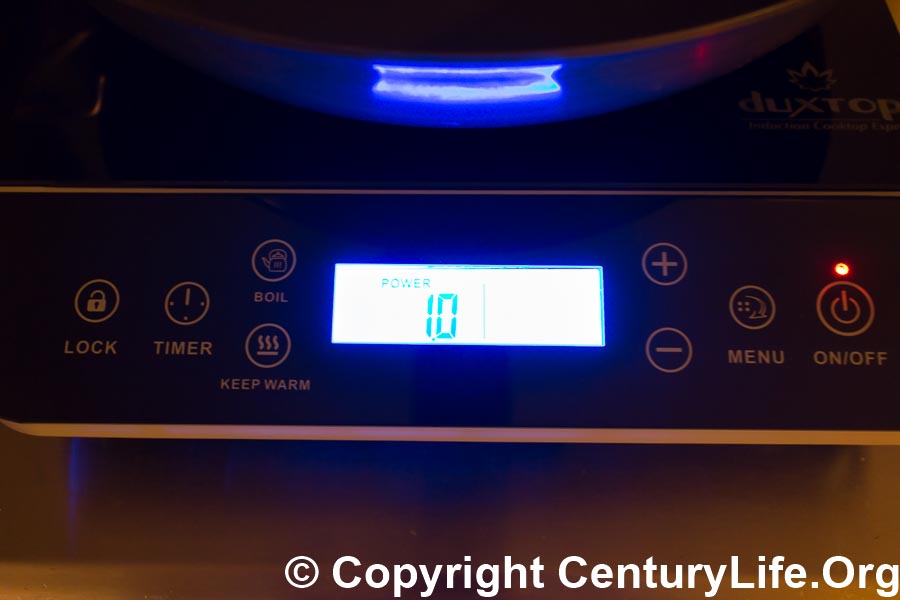
The Ugly:
Induction cookers are only compatible with cookware bottoms where a magnet strongly sticks (as in, you could probably hang an apple off the magnet and it still would not come off). It is not compatible with aluminum cookware unless that aluminum is capped off on the bottom by a thin layer of magnetic stainless steel. If you want to use all-aluminum/copper cookware, or non-magnetic stainless steel, then you have to use an interface disk such as the VonShef Induction Hob Heat Diffuser Stainless Steel with Heat Proof Handle (9.25″). And I would advise against using such a converter disc because it turns your responsive induction burner into an unresponsive hot plate, and the disc will reach far higher temperatures than the pan due to the thermal inefficiency of transferring heat across microscopic air gaps between the converter disc and the bottom of your pan (neither of which are perfectly flat). This means a) more waste heat goes into your kitchen, b) slower cooking times, and c) possible damage to your induction cooker because the disc reaches far higher temperatures than naturally induction-compatible cookware would reach.
And by the way you can use any induction-compatible cookware with any induction burner. You do not have to buy any particular brand. If you aren’t sure if your existing cookware will work, take a kitchen magnet and see if it sticks strongly to any pots or pans. If so, then those pots and pans are induction-compatible. If none of your cookware is strongly magnetic on the bottom, then I’d recommend something like Cuisinart MCP.
Conclusion:
The subject of this review, the Secura LCD Duxtop 9600LS 1800-Watt Portable Induction Cooker (Countertop Burner), is a worthwhile upgrade over the Duxtop 1800-Watt Portable Induction Cooktop Countertop Burner 9100MC. The 9600LS has a 10-hour timer, compared to 170 minutes for the 9100MC; the 9600LS has better safety features to lock out unauthorized users (kids and pets); and the 9600LS has better low-wattage control to prevent scorching and to make for a smoother simmering experience. The fan isn’t quiet, and the coil is typical for sub-$250 induction cookers, but overall, the 9600LS is the best induction cooker you can find for less than $250 and worth the modest increase in price compared to the 9100MC. (The only exception is if you don’t plan to use the unit at lower power levels, ever. If you just want something to boil water quickly and will always use maximum power, then just get the 9100MC.)
The next step up from the Duxtop 9600LS is the $250 Vollrath Mirage Cadet, which gives you 20 power levels and a slightly more rugged build quality. I own both and can tell you flat out that the Cadet is not worth the extra cost over the Duxtop 9600LS. To do appreciably better than the Vollrath Mirage Cadet, you would have to step up to the $500 Vollrath 59500P Mirage Pro Countertop Induction Range, 14-Inch (I review it here) which boasts 100 power levels and a slightly larger coil.
FOOTNOTES

